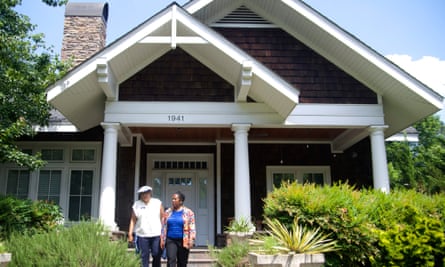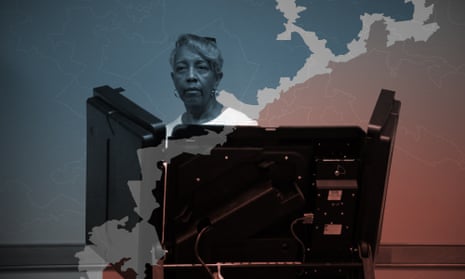On the outskirts of Charlotte, it’s the last day of early voting for the congressional race in North Carolina’s 12th district at the Mountain Island library, and there are no lines for the polling stations.
Instead, volunteers outnumbered the voters. It was early voting time, but not for a race nearly as high-profile as the presidential election. Only 266 people turned out in June to the polls to pick the district’s next member of Congress. After the election, once all the votes were tallied, only 7% of more than 500,000 registered voters cast ballots.
“Turnout was very, very low,” said Carol Johnson, a poll worker and an employee for the city of Charlotte. “Maybe people didn’t know. Maybe they weren’t interested.”
Or maybe people have grown disenfranchised after living in what has long been considered the most gerrymandered district in the United States. Twenty-five years ago, North Carolina lawmakers drew the 12th district, creating the second majority-minority district in a state with a dark history of denying black residents their voting rights.
That line-drawing is what is known as gerrymandering, or manipulating the boundaries of electoral districts to favor a particular result.
The district’s borders were long and narrow – so stretched out that it took a two-hour drive from Charlotte, passing through Winston-Salem and Greensboro, before ending in Durham. Naturally, it became known as the I-85 district because, as state representative Mickey Michaux, a Democrat from Durham, once put it: “If you drove down the interstate with both car doors open, you’d kill most of the people in the district.”
What gerrymandering can kill is the impact of a person’s vote. North Carolina is a prime example of why Barack Obama and former US attorney general Eric Holder recently announced plans to launch a long-term redistricting reform effort. And after Donald Trump escalated his warnings that this year’s presidential election is rigged, several commentators and even the Daily Show’s Trevor Noah argued that gerrymandering along with voter suppression laws are the real rigging.
The state’s past two presidential races were determined by a margin of two percentage points, yet the simple act of map-drawing distorted electoral outcomes on the ballot. Two years ago, more than half the state’s voters cast Democratic ballots, yet Republicans secured the vast majority of congressional seats. For proof of gerrymandering’s chilling effects, look no further than the way that the 12th – which over the years has been described as a serpentine, political pornography and nothing “natural on this planet” – has undercut the power of a single vote.
Opponents of gerrymandering fear the voices of voters may be washed out in the upcoming presidential election, even as statewide restrictions that have been intensively litigated pose potentially more direct obstacles to voting.
This coming term, the US supreme court will review the long-running battle over line-drawing.
‘An uncomfortable resemblance to political apartheid’
The most gerrymandered district emerged after years of battles against discriminatory voting practices. In the decades after the landmark Voting Rights Act of 1965 outlawed voting restrictions such as literacy tests, voting rights lawyers continued to challenge discriminatory election practices still on the books in southern states – forcing changes to ensure their compliance with the Voting Rights Act.
Over the course of several decades, North Carolina’s population grew enough to gain a 12th congressional seat following the 1990 census. The 12th, the state’s second majority-minority district, was intended to boost minority representation.
Mel Watt, a black Charlotte-based lawyer and political operative, seized on the opportunity. He had helped Harvey Gantt get elected as Charlotte’s first black mayor in the early 80s.
“I got on the phone to call Harvey,” hoping to persuade him to run, Watt recalls. “He said, ‘I’m not going to run.’ He instead talked me into running.”
Watt won in 1992, and then more than 10 times after that in the majority black district. But during his tenure, the US supreme court took issue with the district’s consideration of race in its line-drawing numerous times.
In 1993, then Justice Sandra Day O’Connor said districts such as the 12th – which was drawn by the Democratic-led house – bore “an uncomfortable resemblance to political apartheid” that reinforced the “very patterns of racial bloc voting that majority-minority districting is sometimes said to counteract.”
North Carolina soon found itself in a bind: it needed to ensure black votes actually mattered, all while drawing districts without explicitly having race in mind. The supreme court’s Shaw v Reno ruling sparked lawsuits that challenged the constitutionality of majority-minority districts in Georgia, Texas, Florida and Louisiana. The 12th district’s map had to be redrawn repeatedly, a total of four times, through 2010.
How will the election be decided?
The president is chosen through the electoral college, in which each state is assigned a
Battle of the partisan lines
By the time of the 2010 census, Republicans had taken over the statehouse and soon after reworked the congressional district maps to increase the likelihood that its candidates would secure more seats. As the districts changed, North Carolina lawmakers also passed new restrictions that prohibited voters from registering on election day and required IDs to cast ballots. The US supreme court struck down a key provision of the Voting Rights Act, further gutting election laws in the Tar Heel State.
With new GOP-drawn borders, Republicans in 2012 won nine of the state’s 13 congressional seats even though Democrats cast more votes statewide. Two years later, Republicans picked up an additional seat despite the fact more Democrats were registered to vote.
The Rev William Barber, the preacher behind the left-leaning Moral Monday movement, criticized the GOP-backed plan for containing “apartheid voting districts ” that were designed to disenfranchise African-American voters. “Apartheid is not the way for our representatives to be elected,” said civil rights lawyer Adam Stein earlier this year at an NAACP press conference. “North Carolina citizens have been put into districts because of their race rather than where they live.”
There had long been calls to remove politics from the redistricting process. Last year three state lawmakers – a Democrat and two Republicans – dropped separate bills that were ultimately unsuccessful. State representative Jeff Jackson, a Democrat and the author of one of those measures, says he nearly copied word-for-word an old Republican bill from its days as the minority party – but to no avail.
“It’s like monkeys throwing darts,” Jackson says of the current process. “Virtually any system of redistricting would be far superior than what North Carolina has now.”
If passed, Jackson’s proposal would have established an impartial nine-person commission tasked with drawing maps starting in 2030. But Daniel Rufty, chairman of North Carolina’s Republican party in the 12th district, considers independent redistricting to be a “naïve” idea. Whatever changes, whenever the changes happen, he says a new method of map drawing would still require appointees to oversee the process. Who will be appointing those individuals? Partisan officials.
“The 12th district doesn’t make sense,” Rufty says. “It was drawn for partisan reasons that, like it or not, are constitutional. I don’t exactly like it like that. But it is what it is.”
For now, the 12th district is no longer gerrymandered. A federal court tossed out the map in February as it pointed to evidence that “race was the only nonnegotiable criterion” used in drawing the district borders, and the legislature has since redrawn the district.
But while the 12th is more compact, black people no longer account for the majority of registered voters like they once did.
Several residents appealed to challenge the court ruling. Now the issue – which threw some congressional primaries into chaos this past June – has landed on the US supreme court’s fall docket. Lawyers challenging the lower court’s decision argue the judges made their decision based on political affiliation rather than just race.
“It remains undisputed that there is a very high correlation between African American voters and voters who regularly vote a straight Democratic ticket and support national Democratic candidates,” the lawyer says.
If the US supreme court overturns the rulings, it’s likely that lawmakers would need to redraw the 12th’s maps yet again. No matter the ruling, though, the effects of a quarter-century of gerrymandering in the 12th won’t be undone overnight. Michael Dickerson, director of the Mecklenburg County board of elections, said that only 37,400 people of 520,000 registered voters cast ballots in the state’s last election – the postponed June congressional primary.

Congresswoman Alma Adams, who represents the 12th, won a heated primary with six other candidates. But if the incumbent Democrat gets re-elected next month – which is likely since Democrats outnumber Republicans there by a two-to-one margin – she will have done so with just 2% of total registered voters. She concedes winning that way, though beneficial to her, is a “disservice” to the wider district.
Without broader redistricting reform, she says, the lasting effects of gerrymandering could continue to dissuade constituents from casting ballots.
“People get discouraged,” Adams said. “They don’t bother to vote.”
